Use sous vide and your grill to simplify a stunning holiday meal.
Beef prime rib is a popular roast around the holidays. But like the Thanksgiving turkey, it takes hours to cook, and it takes up room in the oven that could be used for side dishes. Sous vide que to the rescue! Cooking the roast sous vide then searing it on the grill solves all kinds of problems. First, you can cook the meat ahead of time, and you can even bring it somewhere else for the final searing and browning. Use their grill instead of yours! Second, sous vide is a set-it-and-forget-it process, so you don’t have to baby the meat as it cooks. Third, you don’t need to use an indoor oven at all.
When you get a whole beef prime rib direct from the butcher, it needs some prep so it will cook properly. You can’t just season the whole thing and cook it. I discuss the problems and solutions in detail in my article on the science of beef roasts. In summary: We want the roast to have as much surface area as possible so the salt and spices can amp up the flavor. We want the meat as round as possible for even cooking and browning, and we want to reverse sear it so we don’t have a layer of overcooked meat beneath the surface. Here’s a video of the whole butchery process. If you prefer to read and look at picture, check out the summary and how-to description below. I also share a mini-recipe for cooking your prime rib with the sous vide que method.
After you break the primal down, you might just want to skin the roast and cut it into ribeye steaks. A great idea!
Anatomy of a beef rib roast
If you want to cook a whole beef prime rib, here’s what to do. The rib primal (below) a.k.a. the rib roast a.k.a. standing rib roast, is a complex collection of muscle meat, fat, and bone. A full rib primal is 7 or 8 bones long and usually 14 to 18 pounds depending on the size, age, breed of the steer, and how much fat and bone the butcher leaves on.
Like what you’re reading? Click here to get Smoke Signals, our free monthly email that tells you about new articles, recipes, product reviews, science, myth-busting, and more. Be Amazing!
USDA Choice runs $15 to $20 per pound at the time of this writing. USDA Prime or wagyu will obviously cost more. Remember, it is called prime rib because the cut is technically called a rib primal, even though it is not necessarily graded USDA prime. Nor does it need to be. This is the same cut that can be sliced into ribeye steaks, among the most flavorful, juicy, and tender steaks on the steer.

The rib roast has a slab of ribs, called back ribs, and they are analogous to baby back ribs from a hog. There are three muscles: The longissimus dorsi, a.k.a. the eye of the ribeye, the spinalis dorsi, a.k.a. the rib cap, and a small muscle called the lip or nose. All three are separated by a layer of fat called seam fat and covered by a thick layer of waxy fat called the fat cap.
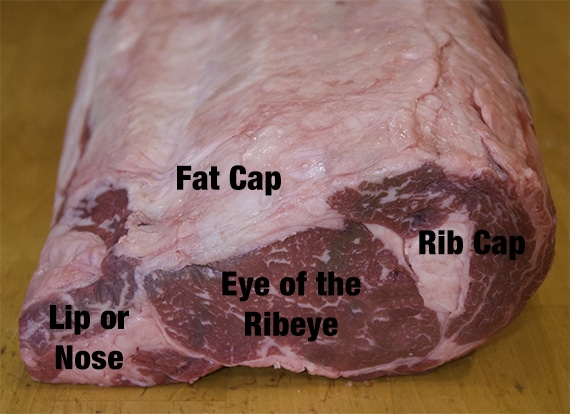
Remove the bones
First of all, the bones must come off. Left on, they insure that the meat will cook unevenly by blocking heat from one third of the roast. So if you cook the roast to medium rare in the center, it will be rare and stringy near the bones. The bones also block salt from penetrating. Plus, with the bones on, one third of the meat can’t be flavored with rub and can’t be browned, so a big part of the roast will be missing those delicious Maillard reaction flavors. Besides, beef backribs make a great meal for 2 to 3 all by themselves. Cut them off and set them aside for later.
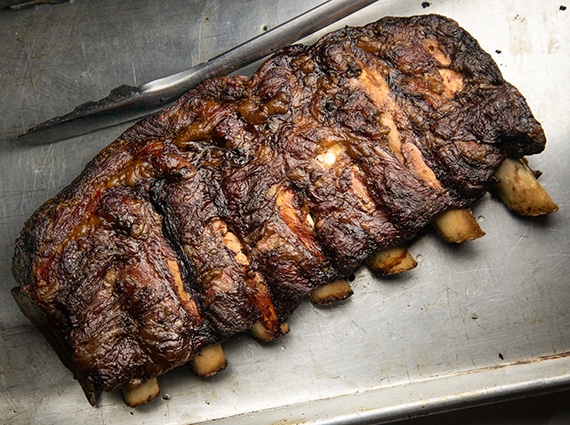
Remove the fat
Next, the fat must come off. It is a myth that fat can penetrate the meat. Fat is oil, and meat is 70% water, and oil and water don’t mix. The melting fat just runs off the meat. It can’t penetrate. No way. No how. Nor can it add flavor at normal roasting temperatures. Fat, when seared at high temperatures, turns amber and creates great flavors, but that only happens at high temperatures, preferably with infrared radiation.
Worse, if you leave the fat cap on, all your rub is on top of the fat, and when you serve the meat, the first thing your guests do is cut off the surface fat. There goes your flavorful rub. You want your rub right on the surface of the muscle. Yes, I know. Fat is flavor. But not surface fat. The fat that is important for flavor is the marbling, the thin web of fat woven throughout the muscle. Here is a closeup of the marbling on a wagyu ribeye steak. Wagyu is a breed of beef descended from Japanese cattle, and it is prized for its extensive marbling. Most meat contains about about 10% marbling, but as you can see, this expensive wagyu meat has more than 50% fat. Put it on your bucket list and start saving now.
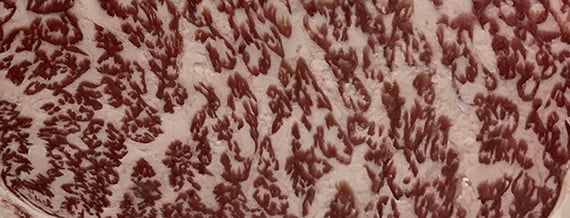
The “nose” is a strip of meat and fat that runs along the length of the eye of the ribeye. There is a little meat there, so cut off the nose (despite the face!) and use it for stew meat or a stir fry. Remove the fat from it first. That beautiful white fat in the nose can be frozen and/or rendered. It can be ground into burgers, sausage, and meatloaf, or it can be melted and painted on steaks in the high heat searing process to enhance the seared fat flavor so essential to a great steak. I discuss this concept in more detail in my article on steakhouse steaks. Or you can just render it and use the beef fat to fry potatoes.
Like what you’re reading? Click here to get Smoke Signals, our free monthly email that tells you about new articles, recipes, product reviews, science, myth-busting, and more. Be Amazing!
Remove the rib cap
The rib cap, the spinalis dorsi, is the single best muscle on the steer. If you leave it on the roast, it inevitably overcooks and browns as in this picture. A terrible waste.
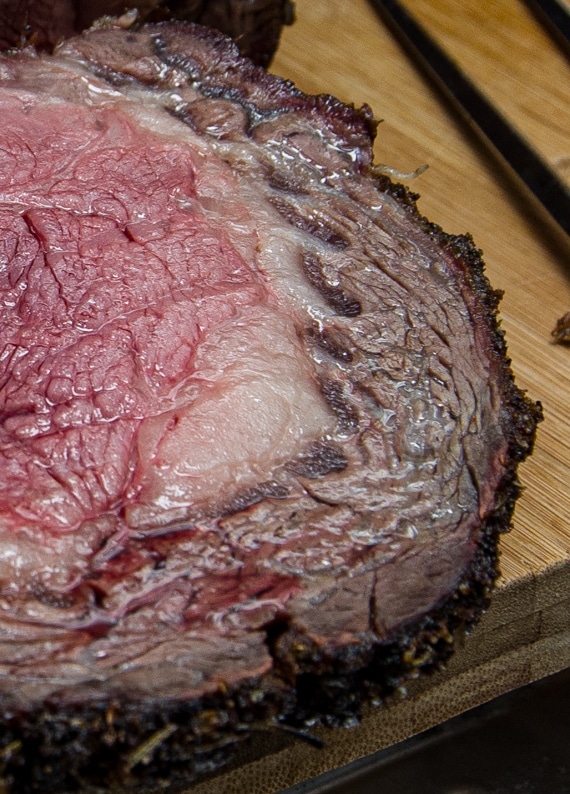
But if you remove it and trim off the silverskin and fat, it is about the size of a flank steak, giving you enough meat for 4 people or more. Grill the rib cap hot and fast like a flank steak.
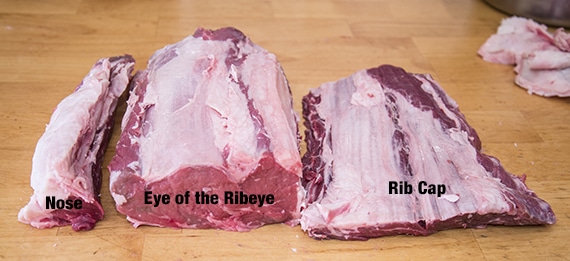
Sous vide que and the rib roast
Now that the meat is prepped, here’s a quick rundown of how to cook it sous vide que. The “recipe” here is in the form of a story instead of the typical recipe. Follow me here and you’ll be serving a fantastic holiday meal to your guests!
So every Christmas, guess who is in charge of the meat for 15 to 20 people? For many years, I have been bringing a massive rib roast to someone else’s house and reverse searing it on their grill. The results have been fabulous, but there have been ongoing problems. Because I am working on somebody else’s grill, usually gas, and because the weather outside can be below zero, I need to get to the party several hours before it starts. I am also underfoot of the hostess, and I am constantly going in and out to baby the grill, checking the temp and the flame. Everyone is grateful for the meat, but I hear grumbling in the background because it is hard for me to say precisely when the meat will be done. People want to know when dinner is! And the twice baked potatoes need to know so they can be baked the second time. And the cold air comes in the house through the back door with me.
This year, I finally solved the problem. I told everyone that dinner would be at 6 sharp. On Christmas Eve, I butchered the roast as shown in the video above, salted the eye or ribeye, and vacuum bagged the parts. On Christmas Day, about noon, I put the eye of the ribeye roast into a sous vide bath at 131°F. At 4 p.m. I dumped out the water and put the roast in a small beer cooler and went over the river and through the woods to my niece’s home, about a 30 minute drive. When I got there, the meat was still plenty warm. I filled the cooler with warm tap water, put my Joule immersion circulator in the water, set it for 131°F, poured myself a drink, filled a plate with appetizers, and joined the party.
Explore the world of Sous Vide Que, the ultimate marriage of water and smoke, by clicking here to download our ebook “Sous Vide Que Made Easy” for $3.99 on Amazon (free Kindle app runs on all computers). Or get the book and others FREE as a member of the AmazingRibs.com Pitmaster Club. Click here to join.
At 5 p.m. I fired up my niece’s Weber Spirit (an inexpensive gas grill) on high, took the meat out of the water, cut open the bags, removed the meat, and covered it with Mrs. O’Leary’s Cow Crust. At about 5:10, I put on my coat, went out back, put the meat over direct infrared heat as hot as I could get it, left the lid open, and seared the snot out of one side. I then rolled the roast about a quarter turn, seared, rolled, seared, rolled, and seared, rolled until I had a nice dark brown crust all over. I then brought the roast inside, sliced it (no resting), and at 6 p.m. sharp, we sat down to eat. Christmas dinner on time! Only one trip to the grill! Perfect results. The beef was fabulously tender, juicy, flavorful, and as you can see from the picture at the top of the page, rosy red from edge to edge.
And to all, a good night.



High quality websites are expensive to run. If you help us, we’ll pay you back bigtime with an ad-free experience and a lot of freebies!
Millions come to AmazingRibs.com every month for high quality tested recipes, tips on technique, science, mythbusting, product reviews, and inspiration. But it is expensive to run a website with more than 2,000 pages and we don’t have a big corporate partner to subsidize us.
Our most important source of sustenance is people who join our Pitmaster Club. But please don’t think of it as a donation. Members get MANY great benefits. We block all third-party ads, we give members free ebooks, magazines, interviews, webinars, more recipes, a monthly sweepstakes with prizes worth up to $2,000, discounts on products, and best of all a community of like-minded cooks free of flame wars. Click below to see all the benefits, take a free 30 day trial, and help keep this site alive.
Post comments and questions below
1) Please try the search box at the top of every page before you ask for help.
2) Try to post your question to the appropriate page.
3) Tell us everything we need to know to help such as the type of cooker and thermometer. Dial thermometers are often off by as much as 50°F so if you are not using a good digital thermometer we probably can’t help you with time and temp questions. Please read this article about thermometers.
4) If you are a member of the Pitmaster Club, your comments login is probably different.
5) Posts with links in them may not appear immediately.
Moderators